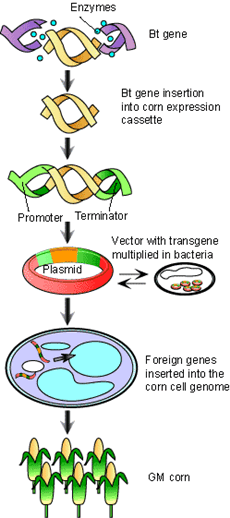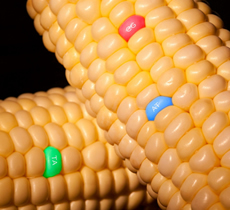Agriculture
Applications of genetic engineering in agriculture and the food industry could increase world food supplies, reduce environmental problems associated with food production, and enhance the nutritional values of certain foods.
However, these benefits are countered by food-safety concerns, the potential for ecosystem disruption, and fears of unforeseen consequences resulting from altering natural selection. Humans rely on plants and animals as food sources and have long used microbes to produce foods such as cheese, bread, and fermented beverages.
Conventional techniques such as cross-hybridization, production of mutants, and selective breeding have resulted in new varieties of crop plants or improved livestock with altered genetics. However, these methods are relatively slow and labor-intensive, are generally limited to intraspecies crosses, and involve a great deal of trial and error.
Transgenic Technology
Recombinant DNA techniques, which manipulate cells? deoxyribonucleic acid (DNA), developed in the 1970?s enable researchers rapidly to make specific, predetermined genetic changes. Because the technology also allows for the transfer of genes across species and kingdom barriers, an infinite number of novel genetic combinations are possible.
The first animals and plants containing genetic material from other organisms (transgenics) were developed in the early 1980?s. By 1985 the first field trials of plants engineered to be pest-resistant were conducted.
In 1990 the U.S. Food and Drug Administration (FDA) approved chymosin as the first substance produced by modified organisms to be used in the food industry for dairy products such as cheese. That same year the first transgenic cowwas developed to produce human milk proteins for infant formula. The well-publicized Flavr Savr tomato, modified to delay ripening and rotting, obtained FDA approval in 1994.
Goals and Uses
By the mid-1990?s, more than one thousand genetically modified crop plants were approved for field trials. The goals for altering food crop plants by genetic engineering fall into three main categories: to create plants that can adapt to specific environmental conditions to make better use of agricultural land, increase yields, or reduce losses; to increase nutritional value or flavor; and to alter harvesting, transport, storage, or processing properties for the food industry. Many genetically modified crops are sources of ingredients for processed foods and animal feed.
Herbicide-resistant plants, such as the Roundup Ready soybean, can be grown in the presence of glyphosphate, an herbicide that normally destroys all plants with which it comes in contact. Beans from these plants were approved for food-industry use in several countries, but there has been widespread protest by activists such as Jeremy Rifkin and environmental organizations such as Greenpeace.
Frost-resistant fruit containing a fish antifreeze gene, insect-resistant plants with a bacterial gene that encodes for a pesticidal protein (Bacillus thuringiensis), anda viral disease-resistant squash are examples of other genetically modified food crops that have undergone field trials.
Scientists have also created plants that produce healthier unsaturated fats and oils rather than saturated ones. Genetic engineering has yielded coffee plants whose beans are caffeine-free without processing and tomatoes with altered pulp content for improved canned products.
Genetically modified microbes are used for the production of food additives such as amino acid supplements, sweeteners, flavors, vitamins, and thickening agents. In some cases, these substances had to be obtained from slaughtered animals. Altered organisms are also used for improving fermentation processes in the food industry.
Food and Environmental Issues
Food safety and quality are at the center of the genetically engineered food controversy. Concerns include the possible introduction of new toxins or allergens into the diet and changes in the nutrient composition of foods. Proponents argue that food sources could be designed to have enhanced nutritional value.
A large percentage of crops worldwide are lost each year to drought, temperature extremes, and pests. Plants have already been engineered to exhibit frost, insect, disease, and drought resistance. Such alterations would increase yields and allow food to be grown in areas that are currently too dry or infertile, positively impacting the world food supply.
Environmental problems such as deforestation, erosion, pollution, and loss of biodiversity have all resulted, in part, from conventional agricultural practices. Use of genetically modified crops could allow better use of existing farmland and lead to a decreased reliance on pesticides and fertilizers.
Critics fear the creation of ?superweeds??either the engineered plants or new plant varieties formed by the transfer of recombinant genes conferring various types of resistance to wild species.
These weeds, in turn, would compete with valuable plants and have the potential to destroy ecosystems and farmland unless stronger poisons were used for eradication. The transfer of genetic material to wild relatives (outcrossing, or ?genetic pollution?) might also lead to the development of new plant diseases. As with any new technology, there may be other unpredictable environmental consequences.
- The Benefits Of Agricultural
Agricultural biotechnology is any technique in Which living organisms, or parts of organisms are altered to make or modify agricultural products, to improve crops, or develop microbes for specific uses in agricultural processes. Simply put, when the...
- 8 Reasons Gmos Are Bad For You
Genetically modified organisms, or GMOs, are created when a gene from one species is transferred to another, creating something that would not be found in nature. A large percentage of domestic crops (up to 85% of soybean yields) have DNA that was tweaked...
- The Right To Know What You Are Eating
BY: Gary Hirshberg and Eric Schlosser An unprecedented agricultural experiment is being conducted at America's dinner tables. While none of the processed food we ate 20 years ago contained genetically engineered ingredients, now 75 percent of it does...
- Genetically Modified Foods And Organisms
What are Genetically Modified (GM) Foods? Although "biotechnology" and "genetic modification" commonly are used interchangeably, GM is a special set of technologies that alter the genetic makeup of organisms such as animals, plants, or bacteria. Biotechnology,...
- Genetically Modified Foods And Organisms
What are Genetically Modified (GM) Foods? Although "biotechnology" and "genetic modification" commonly are used interchangeably, GM is a special set of technologies that alter the genetic makeup of organisms such as animals, plants, or bacteria. Biotechnology,...
Agriculture
Genetically Modified Foods
 |
| Genetically Modified Foods |
However, these benefits are countered by food-safety concerns, the potential for ecosystem disruption, and fears of unforeseen consequences resulting from altering natural selection. Humans rely on plants and animals as food sources and have long used microbes to produce foods such as cheese, bread, and fermented beverages.
Conventional techniques such as cross-hybridization, production of mutants, and selective breeding have resulted in new varieties of crop plants or improved livestock with altered genetics. However, these methods are relatively slow and labor-intensive, are generally limited to intraspecies crosses, and involve a great deal of trial and error.
Transgenic Technology
Recombinant DNA techniques, which manipulate cells? deoxyribonucleic acid (DNA), developed in the 1970?s enable researchers rapidly to make specific, predetermined genetic changes. Because the technology also allows for the transfer of genes across species and kingdom barriers, an infinite number of novel genetic combinations are possible.
 |
 |
The first animals and plants containing genetic material from other organisms (transgenics) were developed in the early 1980?s. By 1985 the first field trials of plants engineered to be pest-resistant were conducted.
In 1990 the U.S. Food and Drug Administration (FDA) approved chymosin as the first substance produced by modified organisms to be used in the food industry for dairy products such as cheese. That same year the first transgenic cowwas developed to produce human milk proteins for infant formula. The well-publicized Flavr Savr tomato, modified to delay ripening and rotting, obtained FDA approval in 1994.
Goals and Uses
 |
| Goals and Uses |
Herbicide-resistant plants, such as the Roundup Ready soybean, can be grown in the presence of glyphosphate, an herbicide that normally destroys all plants with which it comes in contact. Beans from these plants were approved for food-industry use in several countries, but there has been widespread protest by activists such as Jeremy Rifkin and environmental organizations such as Greenpeace.
Frost-resistant fruit containing a fish antifreeze gene, insect-resistant plants with a bacterial gene that encodes for a pesticidal protein (Bacillus thuringiensis), anda viral disease-resistant squash are examples of other genetically modified food crops that have undergone field trials.
Scientists have also created plants that produce healthier unsaturated fats and oils rather than saturated ones. Genetic engineering has yielded coffee plants whose beans are caffeine-free without processing and tomatoes with altered pulp content for improved canned products.
Genetically modified microbes are used for the production of food additives such as amino acid supplements, sweeteners, flavors, vitamins, and thickening agents. In some cases, these substances had to be obtained from slaughtered animals. Altered organisms are also used for improving fermentation processes in the food industry.
Food and Environmental Issues
 |
| Food and Environmental Issues |
A large percentage of crops worldwide are lost each year to drought, temperature extremes, and pests. Plants have already been engineered to exhibit frost, insect, disease, and drought resistance. Such alterations would increase yields and allow food to be grown in areas that are currently too dry or infertile, positively impacting the world food supply.
Environmental problems such as deforestation, erosion, pollution, and loss of biodiversity have all resulted, in part, from conventional agricultural practices. Use of genetically modified crops could allow better use of existing farmland and lead to a decreased reliance on pesticides and fertilizers.
Critics fear the creation of ?superweeds??either the engineered plants or new plant varieties formed by the transfer of recombinant genes conferring various types of resistance to wild species.
 |
| Stop Failing Carbohydrates Diets |
These weeds, in turn, would compete with valuable plants and have the potential to destroy ecosystems and farmland unless stronger poisons were used for eradication. The transfer of genetic material to wild relatives (outcrossing, or ?genetic pollution?) might also lead to the development of new plant diseases. As with any new technology, there may be other unpredictable environmental consequences.
- The Benefits Of Agricultural
Agricultural biotechnology is any technique in Which living organisms, or parts of organisms are altered to make or modify agricultural products, to improve crops, or develop microbes for specific uses in agricultural processes. Simply put, when the...
- 8 Reasons Gmos Are Bad For You
Genetically modified organisms, or GMOs, are created when a gene from one species is transferred to another, creating something that would not be found in nature. A large percentage of domestic crops (up to 85% of soybean yields) have DNA that was tweaked...
- The Right To Know What You Are Eating
BY: Gary Hirshberg and Eric Schlosser An unprecedented agricultural experiment is being conducted at America's dinner tables. While none of the processed food we ate 20 years ago contained genetically engineered ingredients, now 75 percent of it does...
- Genetically Modified Foods And Organisms
What are Genetically Modified (GM) Foods? Although "biotechnology" and "genetic modification" commonly are used interchangeably, GM is a special set of technologies that alter the genetic makeup of organisms such as animals, plants, or bacteria. Biotechnology,...
- Genetically Modified Foods And Organisms
What are Genetically Modified (GM) Foods? Although "biotechnology" and "genetic modification" commonly are used interchangeably, GM is a special set of technologies that alter the genetic makeup of organisms such as animals, plants, or bacteria. Biotechnology,...


